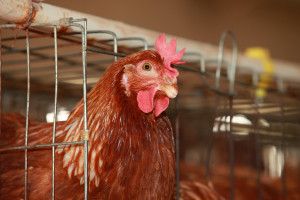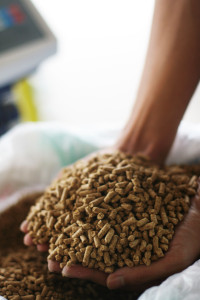The feed consumed by livestock ultimately has a profound effect on the food that ends up on our tables, whether it is meat, eggs, milk or other dairy products. Angela Booth, Technical Assurance Director of AB Agri—a market leader in animal nutrition— talks to EURobiz about some of the challenges in the industry and explains how responsible innovation will be a major contributor to providing a cleaner, more sustainable food supply for the future.
AB Agri enjoys a long history in China, with whom they traded tea as far back as the late 1800s. They made their first investment in 1985 and have been producing animal feed here since 1996.
Although China’s agriculture industry has changed since AB Agri started doing business here, Booth says some of the challenges they found then still apply today, namely “raw material volatility, finding and retaining talent and supply chain quality assurance”.
“China was very different back then, farms were much smaller and there were far fewer large-scale, professional feed producers. The dairy industry was also not significant,” she continues, “Aside from the challenges, there were huge opportunities but very few companies had the luxury of being able to ‘test’ the very exciting yet undiscovered Chinese market.”
Innovation
The rate at which China is consuming food is incredible and will only continue to increase: their annual consumption of animal protein was 71 million tonnes in 2012—more than double that in the United States. Therefore the quality and sustainability of the feed given to livestock is crucially important in assuring a safe and secure food supply.
Making affordable, readily-available quantities of these kinds of feeds presents a formidable challenge to markets like China and Booth believes the best way to address this challenge is through innovation.
Innovation is an important element of AB Agri’s business, such as their research into how to improve feed utilisation and sourcing alternative sources of key ingredients. For example, over the next three years they will be working with the UK Technology Strategy Board to explore growing insect larvae to produce alternative sources of protein to soya in temperate climates. Initiatives like this aim to relieve pressure on supplies of traditional nutrient sources that are also used for human consumption.
AB Vista, a division of AB Agri, is investing GBP 5 million (EUR 5.7 million) per year to develop enzymes that reduce environmental impact while improving efficiency. They launched Quantum Blue in 2012, a product containing phytases, enzymes that, when added to feed, release phosphorus and other nutrients when consumed. This reduces overall feed costs and increases nutritional uptake which in turn reduces pollution risks from manure. This product was developed through collaboration between AB Enzymes and AB Vista and with Roal, their manufacturer in Finland. The global phytase segment is estimated to be in excess of GBP 250 million (EUR 290 million).
In order to get these innovative products onto the market and make an impact in China’s supply chain, AB Agri face a financial challenge. Although the food safety law does not include the whole supply chain, and therefore animal feed, many of the legislative requirements for animal feed in China are similar to those in Europe.
The licensing and registration required for certain products, as well as technical evaluation of a product’s efficacy, stability and environmental impact, that is required before approval of a product is granted is time consuming, which leads to high costs. This in turn can push new generation products beyond the financial reach of many local farmers. Although this evaluation is very much necessary, effective dialogue between industry, scientists and government is increasingly important to improve the efficiency of this process and maintain sufficient product supply.
Control and legislation
In emphasising the crucial role that animal feed plays in the process of ‘plough to plate’ Booth recalls the effects of BSE and Salmonella in Europe, which led to wholesale changes in legislation:
“Having traceability, hygiene and hazard controls right across the supply chain—feed to food —to avoid food safety problems has been mandatory in Europe since the publication of the General Food Law 178 [(EC) No 178/2002] more than a decade ago,” she adds. “Ensuring that we do everything we can to protect the environment during food production is also imperative. It is the responsibility of each link of the supply chain to deliver this, and without it the industry has no future.”
This leads, inevitably, to the question of sustainability. In order to meet demand, production in the industry will need to be intense, but Booth says the impact can be mitigated through their investment into alternative sources of ingredients while looking for alternative co products from the food and drink industry. She also points to their work in measuring the “carbon footprint and biodiversity-on-farm of producers within the food supply chain” through AB Agri’s sustainable supply chain division, AB Sustain.
Many new changes have been made to the feed legislation published in China since the end of 2011, and in the future the as-yet-unpublished Quality and Safety Management Guidelines for Feed will require feed producers to implement Hazard Analysis and Critical Control Points (HACCP), a management system that requires producers to control and prevent chemical, biological and physical hazards throughout their entire process.
Also, says Booth, limitations have been placed on what Chinese non-manufacturers can do in terms of contract manufacturing and marketing claims, although “requirements for other parts of the supply chain are less specific and not linked. Traceability is mandatory in Europe: in China this would also be beneficial but it needs to be practical.”
She emphasises that “the aim of these new requirements is to raise the bar for the industry”, however, the key challenge for China, as it is for Europe, is one of implementation.
An effective method of implementing feed and food safety legislation in Europe to date has been through third-party certification from independent assurance schemes. Booth says that although ISO 22000 and 9001 are already widely applied in China, the effectiveness of these certifications for assuring the feed industry can be argued, “Although the new guidelines for feed management are a step in the right direction, practical schemes that control risks both up and down the supply chain need to be developed and Industry has a role to play in this.”
There isn’t a quick solution when it comes to satisfying China’s insatiable appetite for protein; it will take a combined effort in which providing quality, sustainable feeds plays just one part.
“Maintaining supply at the same time as quality standards requires responsible innovation, cross-supply chain collaboration and practical and proportionate legislative measures. Feeding the animals that feed us— feed security is becoming just as much a global issue as food security,” Booth concludes. “Reducing waste in agri-food stuffs, making safe, valuable materials go further and ensuring supply chain integrity are just some of the things we need to be actively addressing.”
AB Agri, the agricultural division of Associated British Foods plc, operates at the heart of the agri food and drink industry with activities that stretch from ‘plough to plate’. The business’ unique breadth and experience enables it to add value and drive profit for organisations all along the food, drink and biofuel industry supply chain.
Today, AB Agri operates in 70 countries worldwide, supplying products and services to farmers, feed and food manufacturers, processors and retailers through employees in 20 markets operating right across the entire supply chain. For more information go to www.abagri.com.




Great analysis of just how important downstream supply chain decisions are to the price and supply of meat and proteins worldwide. Good, stable sustainable animal feed and logistics is going to have a huge effect on how the world eats in the coming years as developing economies want to consume more meat.